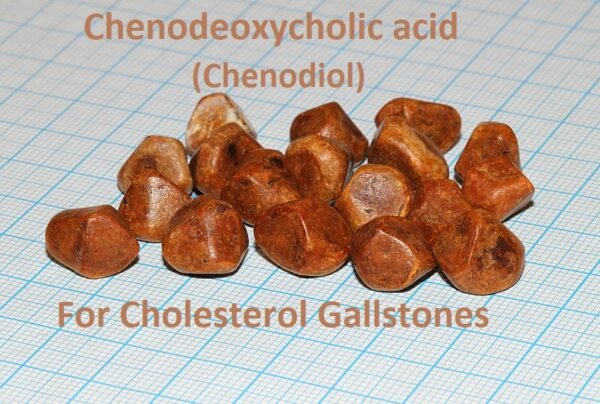Chenodeoxycholic acid (CDCA) is a bile acid, which is a type of steroid acid synthesized in the liver and secreted into the bile. It plays a crucial role in the digestion and absorption of dietary fats and fat-soluble vitamins in the small intestine. CDCA, along with other bile acids, helps emulsify fats, making them more accessible to lipase enzymes for digestion.
Beyond its role in digestion, CDCA has been investigated for its potential therapeutic applications. It's used in the treatment of certain liver diseases, such as primary biliary cholangitis (PBC), where it helps to improve bile flow and reduce liver damage. Additionally, CDCA has been studied for its cholesterol-lowering effects and its potential in the treatment of gallstones.
Chenodeoxycholic acid (chenodiol) is a natural human bile that constitutes about one-third of the bile. It suppresses the synthesis of cholesterol and cholic acid and prevents the cholesterol from being excreted into the bile. Thus, it results in the dissolution of cholesterol gallstones and is used for the treatment of radiolucent cholesterol gallstones as an alternative to surgery. It is also used as an off-label treatment in patients with Cerebrotendinous xanthomatosis (CTX).
Chenodeoxycholic acid dose in adult:
Chenodeoxycholic acid as monotherapy for Gallstone dissolution:
- The typical starting dose is 250 milligrams taken twice a day for the first two weeks.
- After that, the dose increases by 250 milligrams every week until either the recommended dose or the highest dose you can handle without side effects is reached.
- For ongoing treatment to keep the gallstones from coming back, the maintenance dose is usually between 13 to 16 milligrams per kilogram of body weight per day, split into two doses.
It's important to note that doses below 10 milligrams per kilogram are usually not effective and might even increase the risk of needing surgery to remove the gallbladder.
Chenodeoxycholic acid off-label dose in combination therapy of Gallstone dissolution:
- The typical dose is 5 to 7.5 milligrams per kilogram of body weight once a day, usually taken at bedtime.
- This combination therapy involves using chenodeoxycholic acid alongside ursodeoxycholic acid, with or without additional treatments like lithotripsy (a procedure to break up gallstones using sound waves).
Chenodeoxycholic acid off-label use of Chenodeoxycholic acid in the treatment of Cerebrotendinous xanthomatosis :
- The typical dose is 750 milligrams per day, divided into three doses.
- This treatment regimen is usually continued for at least one year.
Chenodeoxycholic acid dose in children:
Chenodeoxycholic acid Dose in Cerebrotendinous xanthomatosis::
For infants, children, and adolescents with cerebrotendinous xanthomatosis, the typical dose of chenodeoxycholic acid varies:
- Usual dose: 10 to 15 milligrams per kilogram of body weight per day, divided into 1 to 3 doses throughout the day.
- Maximum daily dose: 750 milligrams.
For infants and young children, some experts suggest starting with a lower dose of 5 milligrams per kilogram of body weight per day, divided into 3 doses.
Chenodeoxycholic acid dose in Gallstone dissolution:
For children aged 12 years and older and adolescents with gallstones, chenodeoxycholic acid is not routinely used due to limited data and the availability of other treatment options. However, in some cases, it may be considered as an alternative.
The reported dosing regimen is as follows:
- Oral: 15 milligrams per kilogram of body weight per day, divided into 3 doses taken with meals.
Chenodeoxycholic acid dose in Inborn errors of bile acid biosynthesis and steroid dehydrogenase or reductase deficiencies:
- In cases of inborn errors of bile acid biosynthesis, particularly involving deficiencies in steroid dehydrogenase or reductase, treatment approaches are tailored to the specific deficiency and the individual's presentation.
- Because these conditions are rare, treatment guidelines are based on limited data from small case series and reports.
For infants, children, and adolescents with these conditions, the typical initial dose of chenodeoxycholic acid is as follows:
- Oral: Usually starting in the range of 5 to 10 milligrams per kilogram of body weight per day, divided into one or two doses.
- Higher initial doses of 11 to 18 milligrams per kilogram of body weight per day have also been reported.
- Once targeted bile acid levels normalize or stabilize, a maintenance dose of 5 milligrams per kilogram of body weight per day is often initiated.
Pregnancy Risk Factor X
- Pregnancy Risk Factor X means the medicine shouldn't be used by women who are pregnant or might get pregnant because it can harm the baby.
- Studies on animals showed that there were problems for the babies when the medicine was given during pregnancy.
- So, it's a big no for pregnant women or those who might become pregnant.
Use of chenodeoxycholic acids during breastfeeding
- We're not sure if chenodiol passes into breast milk, so the manufacturer advises caution when giving it to nursing mothers.
- It's essential to weigh the potential risks to the baby against the benefits of treatment.
Chenodeoxycholic acid dose in Renal Disease:
- The manufacturer's instructions don't include specific dosage adjustments for people with kidney problems.
Chenodeoxycholic acid in Liver disease:
- For individuals with preexisting liver problems, the manufacturer's instructions don't include specific dosage adjustments, but they advise against using the medication.
- It's also contraindicated in patients with known liver cell dysfunction or bile duct abnormalities.
Hepatotoxicity during treatment:
- During treatment, if liver enzyme levels are elevated (1.5 to 3 times the upper limit of normal) for more than 3 to 6 months, the medication should be temporarily stopped and resumed once enzyme levels return to normal.
- However, if enzyme levels exceed 3 times the upper limit of normal, treatment should be stopped immediately.
- Monitoring liver function closely during treatment is crucial to catch any signs of liver damage early on.
Common Side Effects Of Chenodeoxycholic acid include:
- Endocrine & metabolic:
- Increased LDL cholesterol
- Increased serum total cholesterol
- Gastrointestinal:
- Diarrhea
- Biliary colic
- Abdominal cramps
- Abdominal pain
- Anorexia
- Constipation
- Dyspepsia
- Flatulence
- Heartburn
- Nausea
- Vomiting
- Hematologic & oncologic:
- Leukopenia
- Hepatic:
- Increased serum transaminases
Contraindications to Chenodeoxycholic acid include:
- Chenodeoxycholic acid should not be used in individuals with known liver cell dysfunction or bile duct abnormalities, such as intrahepatic cholestasis, primary biliary cirrhosis, or sclerosing cholangitis.
- It's also not recommended for those with confirmed non-visualizing gallbladders after two consecutive single doses of dye, or for people with radiopaque stones, gallstone complications, or urgent reasons for gallbladder surgery, like severe acute cholecystitis, cholangitis, biliary obstruction, gallstone pancreatitis, or biliary gastrointestinal fistula.
- Additionally, it's contraindicated during pregnancy or for women who might become pregnant.
Warnings and Precautions
Diarrhoea:
- Chenodeoxycholic acid can cause diarrhea, which is often related to the dosage and affects around 40% of patients.
- It can happen at any point during treatment but is most frequent when treatment begins.
- Typically, the diarrhea is mild and doesn't usually stop the treatment.
- However, in some cases, it can be severe, and the dose might need to be temporarily reduced or stopped altogether.
- Antidiarrheal medications might help some patients manage this side effect.
Hepatotoxicity:
- Chenodeoxycholic acid can lead to liver toxicity, especially at higher doses.
- It's crucial to closely monitor liver enzyme levels in the blood throughout treatment.
- If levels of aminotransferases rise to more than three times the upper limit of normal (ULN), treatment should be stopped immediately.
- Temporary suspension of therapy is recommended if there are transient increases in aminotransferase levels, ranging from 1.5 to 3 times ULN.
- In most cases, liver enzyme levels return to normal after stopping chenodeoxycholic acid.
- Although rare, there have been reports of chronic active hepatitis linked to chenodeoxycholic acid, but a definite cause-and-effect relationship hasn't been established.
Colon cancer:
- Epidemiological studies have hinted at a possible connection between bile acids and an increased risk of colon cancer. However, the evidence is not conclusive and varies. While some research suggests a potential link, other studies have conflicting results. Therefore, we can't entirely dismiss the possibility of a relationship between bile acids and colon cancer, but more research is needed to understand this potential connection better.
Hepatic impairment:
- Chenodeoxycholic acid should be avoided in individuals with preexisting liver problems or elevated liver enzymes.
- It's contraindicated in patients with known liver cell dysfunction or abnormalities in the bile ducts.
- This caution is due to the potential for the medication to worsen existing liver conditions or cause further liver damage.
Chenodeoxycholic acid (chenodiol): Drug Interaction
Note: Drug Interaction Categories:
- Risk Factor C: Monitor When Using Combination
- Risk Factor D: Consider Treatment Modification
- Risk Factor X: Avoid Concomitant Use
|
Risk Factor C (Monitor therapy). |
|
|
Estrogen Derivatives |
It may reduce the therapeutic effects of Chenodiol. When using chenodiol in combination with estrogen derivatives, be sure to monitor the clinical response. |
|
Fibric Acid Derivatives |
The therapeutic effects of Chenodiol may be diminished. When using chenodiol in combination with fibric acid derivatives, be sure to monitor the clinical response. |
|
Vitamin K antagonists (eg warfarin) |
Vitamin K Antagonists may have an anticoagulant effect that Chenodiol might enhance. |
|
Risk Factor D (Regard therapy modification) |
|
|
The serum concentration of Chenodiol may be decreased. Management: To prevent adsorption into the gastrointestinal tract, chenodiol should be administered 2 hours or 6 hours before aluminum-containing anticid products. |
|
|
Bile Acid Sequestrants |
The serum concentration of Chenodiol may be decreased. Management: Chenodiol may be administered 5 hours after the administration of bile acids sequestrants to reduce chenodiol's adsorption into the gastrointestinal tract. Patients receiving bile acids sequestrants should be monitored for decreased therapeutic effects of Chenodiol. |
Monitor:
Serum Aminotransferase Levels:
- Check monthly for the first 3 months of therapy, then every 3 months thereafter. This helps keep an eye on liver function.
Serum Cholesterol:
- Monitor every 6 months to track cholesterol levels.
Oral Cholecystograms and/or Ultrasonograms:
- Perform at 6- to 9-month intervals to see how the therapy is working and if there's any improvement.
Confirmation of Stone Dissolution:
- After dissolving stones, confirm the dissolution 1 to 3 months later to ensure effectiveness of the treatment.
How to administer Chenodeoxycholic acid?
- Meal Consideration: Chenodeoxycholic acid can be taken without regard to meals, meaning you can take it with or without food.
Mechanism of action of Chenodeoxycholic acid:
- Chenodiol, also known as chenodeoxycholic acid, is a bile acid found naturally in the human body, making up about a third of all bile acids.
- In people with cholesterol gallstones, chenodiol is thought to work by reducing the liver's production of cholesterol and another bile acid called cholic acid.
- It also helps to stop the secretion of cholesterol into bile, encouraging the creation of less cholesterol-rich bile, which can then dissolve gallstones over time.
Absorption:
- Chenodeoxycholic acid is quickly and almost entirely absorbed in the upper part of the small intestine.
Distribution:
- It has a large volume of distribution, estimated to be around 1600 liters.
Metabolism:
- The liver converts it into different forms, called taurine and glycine conjugates, which are then released into bile.
- Afterward, it undergoes a process called enterohepatic circulation, where it's reabsorbed and metabolized by bacteria in the colon into another compound called lithocholic acid.
- A small portion of this is absorbed back into the body and converted into sulfolithocholyl conjugates in the liver.
Half-life:
- Chenodeoxycholic acid has a half-life of approximately 45 hours.
Excretion:
- It's mainly eliminated through feces, with about 80% being excreted as lithocholic acid.
Chenodeoxycholic acid International brands:
- Aylehning
- Chebil
- Chendol
- Cheno
- Chenofalk
- Chenossil
- Quenobilan
- Theramatic
Chenodeoxycholic acid Brands in Pakistan:
No brands available in Pakistan







